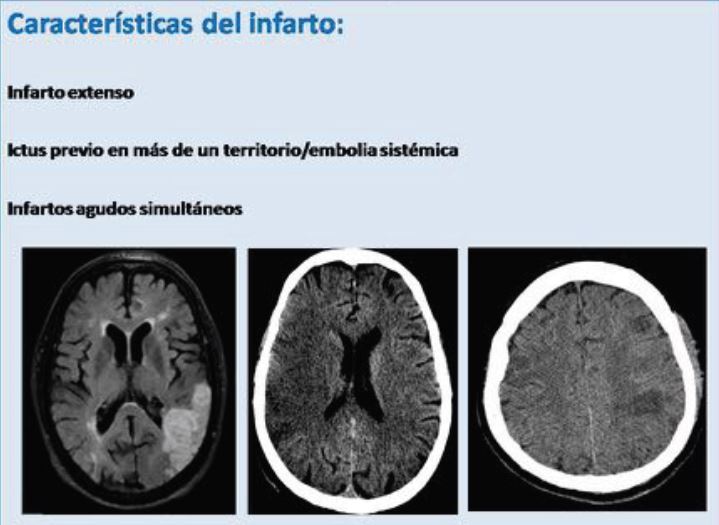HALLAZGOS CARDÍACOS EN PACIENTES CON ICTUS:
LO QUE EL RADIÓLOGO DEBE TENER EN CUENTA.
Palabras clave:
HALLAZGOS CARDÍACOS EN PACIENTES CON ICTUS, poster, seramResumen
Objetivos Docentes
Describir los hallazgos cardíacos, tanto en TC como en RM, que pueden representar una causa potencial de ictus en pacientes con antecedentes de un ictus cardiogénico o de causa no aclarada.
Revisión del tema
El ictus isquémico se puede generar por tres principales causas:
Trombosis intravascular: representa la formación de un trombo a nivel arterial, generalmente debido a ateroesclerosis, disección o displasia fibromuscular.
Embolismo: es necesaria la presencia de un foco emboligeno extra-cerebral desde el cual émbolos de diferente tamaño pueden desplazarse a la circulación cerebral y obstruirla en diferentes territorios vasculares.
Hipoperfusion sistémica: es el resultado de la disminución del normal aporte vascular al cerebro debido a varias causas, la mayoría relacionada con disfunción cardiaca (isquemia miocardica, parada cardiaca, arritmias)
Descargas
Citas
Ferro J M. Cardioembolic stroke: an update, Lancet Neurology 2003; 2: 177–88.
Caplan LR. Basic pathology, anatomy, and pathophysiology of stroke. In: Caplan's Stroke: A Clinical Approach, 4th ed, Saunders Elsevier, Philadelphia 2009. p.22
McArdle PF, Kittner SJ, Ay H, et al. Agreement between TOAST and CCS ischemic stroke classification: the NINDS SiGN study. Neurology 2014; 83:1653.
Arsava EM, Ballabio E, Benner T, et al. The Causative Classification of Stroke system: an international reliability and optimization study. Neurology 2010; 75:1277.ç
Kwang Nam Jin et al. Cardioembolic Origin in Patients With Embolic Stroke: Spectrum of Imaging Findings on Cardiac MDCTAJR 2010; 195:W38–W44
Arboix A et al. Cardioembolic Stroke: Clinical Features, Specific Cardiac Disorders and Prognosis Current Cardiology Reviews, 2010, 6, 150-161ç
J. Díaz Guzmán Ictus cardioembólico: epidemiología Neurología. 2012;27(Supl 1):4-9
Olesen J B Risk Factors for Stroke and Thromboembolism in Relation to Age Among Patients With Atrial Fibrillatio The Loire Valley Atrial Fibrillation Project CHEST 141; 1 JANUARY, 2012
Rustemli A et al. Evaluating Cardiac Sources of Embolic Stroke with MRI Jrnl. of CV Ultrasound & Allied Tech. Vol. 24, No. 3, 2007
Boussel L et al. Ischemic Stroke: Etiologic Work-up with Multidetector CT of Heart and Extraand Intracranial Arteries, Radiology: Volume 258: Number 1—January 2011.
Iajilan A M Impact of Implementing Cardiac CT in Evaluating Patients Suspected of Cardioembolic Stroke J Comput Assist Tomogr • Volume 00, Number 00,Month 2016
Sheffel H et al Atrial Myxomas and Thrombi: Comparison of Imaging Features on CT AJR 2009; 192:639–645
Jin Hur et al Cardioembolic Stroke: Dual- Energy Cardiac CT for Differentiation of Left Atrial Appendage Thrombus and Circulatory Stasis
Williamson E ECG-Gated Cardiac CT Angiography Using 64-MDCT for Detection of Patent Foramen Ovale AJR 2008; 190:929–933.
Morris M et al. CT and MR Imaging of the Mitral Valve: Radiologic-Pathologic Correlation RadioGraphics 2010; 30:1603–1620
A Franco et al. Enfermedad valvular cardíaca. Valoración con tomografía computarizada multidetector Radiología. 2014;56(3):219-228
Cappato R et al. Prevalence and Causes of Fatal Outcome in Catheter Ablation of Atrial Fibrillation JACC Vol. 53, No. 19, 2009
Finsterer J et al. Neurological manifestations of atrio-esophageal fistulas from left atrial ablation European Journal of Neurology 2011, 18: 1212–1219


